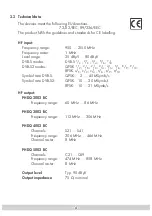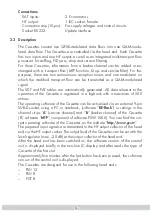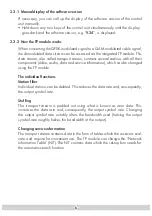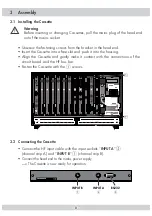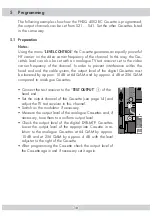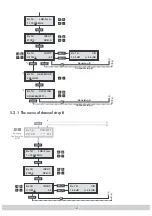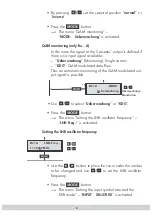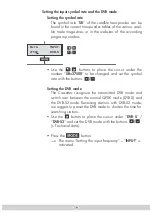
- 5 -
- 5 -
Connections:
SAT inputs:
2 F-connectors
HF output:
1 IEC socket, female
Connection strip (10-pin):
For supply voltages and control circuits
Socket RS 232:
Update interface
2.3 Description
The Cassettes convert two QPSK-modulated data flows into one QAM-modu-
lated data flow. The Cassettes are controlled via the head end. Each Cassette
has two inputs and one HF output, as well as an integrated multi-transport flow
processor for stuffing, PID pass, drop and service filtering.
For these Cassettes, information from a barker channel can be added or ex-
changed with a transport flow (MTP function, Drop- and service filter). For this
purpose, there are two autonomous reception tuners and one modulator on
which the modified transport flow can be transmitted as a QAM-modulated
signal.
The SDT and PAT tables are automatically generated. All data relevant to the
operation of the Cassette is registered in a logbook with a maximum of 500
entries.
The operating software of the Cassette can be actualised via an external 9-pin
SUB-D-socket, using a PC or notebook, (software “
BE-Flash
”) or settings in the
channel strips “
A
” (service channel) and “
B
” (barker channel) of the Cassette
(PC software “
MTP
”, component of software PSW 1000). You can find the cur-
rent operating software of the Cassettes on the website “
http://www.gss.tv
”.
The prepared input signals are transmitted to the HF output collector of the head
end via the HF output socket. The output level of the Cassettes can be set with the
level regulator (max. –20 dB) at the output collector of the head end.
After the head end has been switched on, the software version of the control
unit is displayed briefly in the two-line LC display and afterwards the type of
Cassette of the first slot.
Approximately five minutes after the last button has been pressed, the software
version of the control unit is displayed.
The Cassettes are designed for use in the following head ends:
– PSU
12
– PSU
8
– PGT
8




